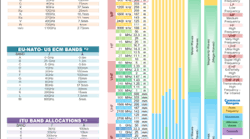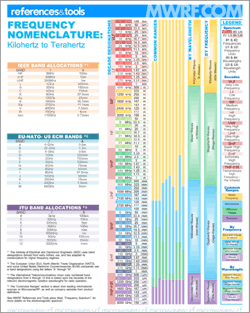Frequency Nomenclature: Kilohertz to Terahertz
By: Jean-Jacques DeLisle
Electromagnetic (EM) radiation, when properly manipulated, can be controlled to produce signals over a definable path that can carry information. The information embedded in an EM signal, or telecommunications signal, travels through the atmosphere according to the varying properties of the radiation that carries it. The behavior of EM radiation carrying telecommunication signals depends largely on the frequency, or cycles per second (Hz), of the signal. The frequencies that can be used for this type of information exchange are referred to as the radio spectrum, from the term radiotelegraphy. As there are many organizations that are competing for frequency ranges in which to operate, organizations like the United States Federation Communications Commission (FCC) have formed to better manage the available spectrum. As radio technology has advanced the nomenclature for frequency ranges within the spectrum, or bands, have changed over time. Many different companies, fields, and organizations used varying designations for these bands. This is shown in the tables in this reference that are below this text.Examples of this include the use of the terms “radio frequency” (RF) and “microwave frequencies”. RF commonly refers to the frequencies in which early radiotelephony was limited as a function of the technological capabilities at the time. The term “microwaves” was coined to describe frequencies that were much smaller in wavelength than radiotelephony frequencies. This nomenclature is not adequately descriptive for all situations, as modern advances are leading the ways to much higher frequencies than in past years.
Millimeter-waves is now a common term in the industry, and remains ambiguous. This is consistent with prior nomenclature in that it may not always describe any particular physical principle. This becomes problematic when one considers the SI base unit “micro” being smaller than “milli”.
There are physical properties, such as frequency and wavelength, which may enable a consistent and accurate naming convention if properly understood. The frequency table on this reference is designed to describe the present nomenclature and show a naming convention based upon physical principles. This may aid the RF/Microwave/Millimeter-wave/Terahertz industry in communicating with other industries as the use of these technologies is penetrating every aspect of human life.
The reference includes a frequency and wavelength range increasing toward the top of the page, and is used to describe the information in the other sections of the reference. Labeled “Decade Designations,”, this section shows the naming of frequency bands using a base-ten system for differentiation. The International Telecommunications Union (ITU) uses band designations number four to 12, which also use the same decade-based system as the common names for the frequency decades.
The “Common Ranges” section is a comparison of what several different sources describe as the ranges for radio frequency, microwaves, millimeter-waves, and terahertz. Both sections “By Wavelength” and “By Frequency” show a naming convention based upon the SI base unit names for wavelengths and frequencies. A legend is included for spot reference. Tables with the ranges of frequency bands recognized by the ITU, The European Union (EU), North Atlantic Treaty Organization (NATO), United States Electronic Countermeasures (US ECM), and the Institute for Electrical and Electronics Engineers (IEEE) are also provided.
See reference, “Frequency Spectrum,” for more details on frequency information.

